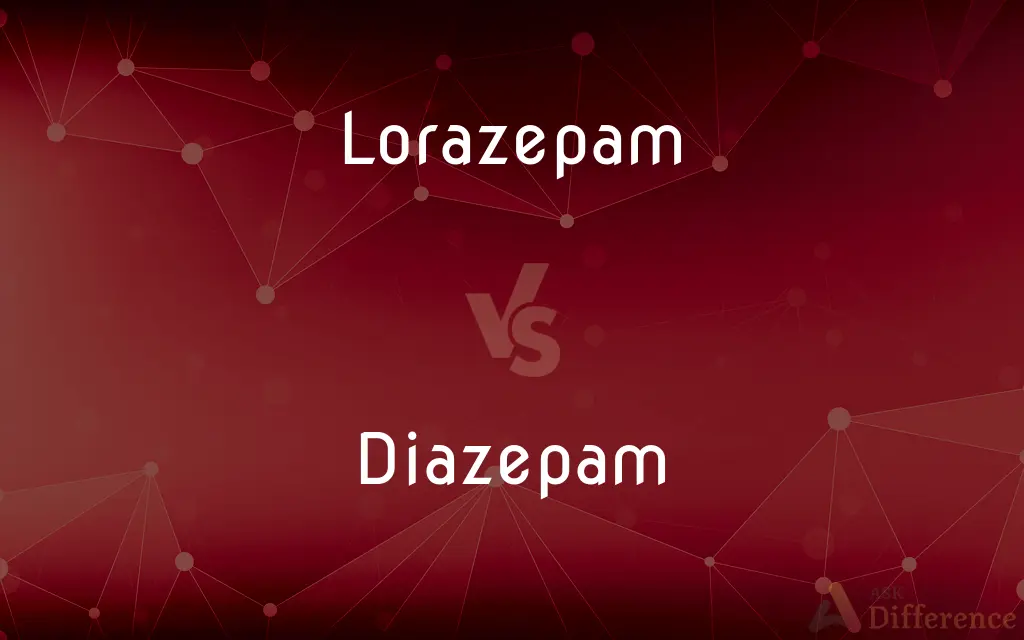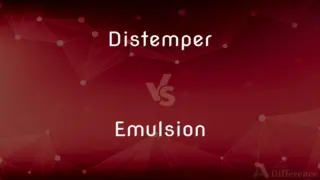Lorazepam vs. Diazepam — What's the Difference?
Edited by Tayyaba Rehman — By Fiza Rafique — Updated on October 24, 2023
Lorazepam and Diazepam are both benzodiazepines, but Lorazepam is primarily used for anxiety, while Diazepam treats anxiety, muscle spasms, and seizures.

Difference Between Lorazepam and Diazepam
Table of Contents
ADVERTISEMENT
Key Differences
Lorazepam and Diazepam are both medications that fall under the benzodiazepine class, known for their sedative properties. Benzodiazepines work by enhancing the effect of the neurotransmitter GABA, which is inhibitory and produces calming effects on the brain.
While both drugs are utilized to treat anxiety disorders, Lorazepam is often favored for its efficacy in treating acute anxiety symptoms and its relatively fast onset of action. On the other hand, Diazepam has a broader range of uses, including the treatment of muscle spasms and certain types of seizures.
Another distinction between Lorazepam and Diazepam is their duration of action. Lorazepam generally has a shorter half-life and is metabolized more quickly than Diazepam, which has a longer half-life and can remain in the system for an extended period.
In the realm of dependency and withdrawal, both Lorazepam and Diazepam have the potential for dependency if misused. It's essential to understand that abrupt discontinuation after prolonged use can lead to withdrawal symptoms, with Diazepam possibly having more prolonged withdrawal due to its longer half-life.
It's crucial for anyone prescribed either Lorazepam or Diazepam to use them under a healthcare professional's guidance. Given their potential side effects and interactions with other medications, proper medical oversight is imperative.
ADVERTISEMENT
Comparison Chart
Primary Uses
Anxiety
Anxiety, muscle spasms, seizures
Class of Drug
Benzodiazepine
Benzodiazepine
Duration of Action
Shorter half-life
Longer half-life
Metabolism
Metabolized quickly
Remains in the system longer
Dependency and Withdrawal
Potential for dependency; shorter withdrawal period
Potential for dependency; more prolonged withdrawal
Compare with Definitions
Lorazepam
A benzodiazepine used primarily to treat anxiety.
The doctor prescribed Lorazepam to help manage her panic attacks.
Diazepam
A benzodiazepine used to treat anxiety, muscle spasms, and seizures.
Diazepam was prescribed for his muscle spasms after the injury.
Lorazepam
A medication with a relatively fast onset of action.
She noticed the calming effects of Lorazepam within an hour.
Diazepam
A drug that works by enhancing the effect of GABA.
Like other benzodiazepines, Diazepam increases the inhibitory actions of GABA.
Lorazepam
A drug that enhances the effect of the neurotransmitter GABA.
Lorazepam works by boosting the inhibitory functions of GABA in the brain.
Diazepam
A drug with a long duration of action due to its extended half-life.
The effects of Diazepam can last longer than some other benzodiazepines.
Lorazepam
A drug known for its sedative effects.
After taking Lorazepam, he felt drowsy and calm.
Diazepam
A medication known for its calming effects.
After a severe panic attack, she was given Diazepam to help her relax.
Lorazepam
A substance with potential for dependency if misused.
It's essential to use Lorazepam only as prescribed to avoid dependency.
Diazepam
A substance with a potential for dependency, especially with prolonged use.
Long-term use of Diazepam can lead to dependency issues.
Lorazepam
Lorazepam, sold under the brand name Ativan among others, is a benzodiazepine medication. It is used to treat anxiety disorders, trouble sleeping, severe agitation, active seizures including status epilepticus, alcohol withdrawal, and chemotherapy-induced nausea and vomiting.
Diazepam
(pharmaceutical drug) A tranquilizing muscle relaxant drug (trademark Valium) used chiefly to relieve anxiety.
Lorazepam
A benzodiazepine drug, C15H10Cl2N2O2, that acts as a sedative and antianxiety agent and is used therapeutically to control seizures.
Diazepam
Diazepam, first marketed as Valium, is a medicine of the benzodiazepine family that acts as an anxiolytic. It is commonly used to treat a range of conditions, including anxiety, seizures, alcohol withdrawal syndrome, benzodiazepine withdrawal syndrome, muscle spasms, insomnia, and restless legs syndrome.
Lorazepam
(pharmaceutical drug) A drug of the benzodiazepine group, used especially to treat anxiety.
Diazepam
A benzodiazepine drug, C16H13ClN2O, used to treat anxiety and alcohol withdrawal and as a sedative, skeletal muscle relaxant, and anticonvulsant.
Lorazepam
Tranquilizer (trade name Ativan) used to treat anxiety and tension and insomnia
Diazepam
A tranquilizer (trade name Valium) used to relieve anxiety and relax muscles; acts by enhancing the inhibitory actions of the neurotransmitter GABA; can also be used as an anticonvulsant drug in cases of nerve agent poisoning
Common Curiosities
Are Lorazepam and Diazepam the same?
No, while both are benzodiazepines, Lorazepam is primarily for anxiety, and Diazepam treats anxiety, muscle spasms, and seizures.
Which lasts longer, Lorazepam or Diazepam?
Diazepam has a longer half-life and lasts longer than Lorazepam.
Can they be taken together?
Only under a doctor's guidance; combining Lorazepam and Diazepam can enhance sedative effects.
Can both drugs cause dependency?
Yes, both Lorazepam and Diazepam can lead to dependency if misused.
Are they safe during pregnancy?
Consult a doctor; benzodiazepines, including Lorazepam and Diazepam, can pose risks.
Can they be used for sleep disorders?
They might be prescribed for sleep issues, but it's not their primary use.
Which is more potent, Lorazepam or Diazepam?
Both are potent but have different primary uses; Lorazepam is more for acute anxiety, while Diazepam has broader applications.
Are they available over the counter?
No, both Lorazepam and Diazepam require a prescription.
What are common side effects?
Both Lorazepam and Diazepam can cause drowsiness, dizziness, and fatigue.
How do they interact with alcohol?
Alcohol can enhance the sedative effects of both Lorazepam and Diazepam and should be avoided.
How long should one be on these medications?
Duration depends on the individual and condition; always consult with a healthcare professional.
Share Your Discovery

Previous Comparison
Distemper vs. Emulsion
Next Comparison
Spark vs. EmberAuthor Spotlight
Written by
Fiza RafiqueFiza Rafique is a skilled content writer at AskDifference.com, where she meticulously refines and enhances written pieces. Drawing from her vast editorial expertise, Fiza ensures clarity, accuracy, and precision in every article. Passionate about language, she continually seeks to elevate the quality of content for readers worldwide.
Edited by
Tayyaba RehmanTayyaba Rehman is a distinguished writer, currently serving as a primary contributor to askdifference.com. As a researcher in semantics and etymology, Tayyaba's passion for the complexity of languages and their distinctions has found a perfect home on the platform. Tayyaba delves into the intricacies of language, distinguishing between commonly confused words and phrases, thereby providing clarity for readers worldwide.
















































